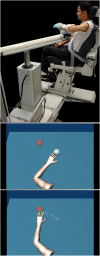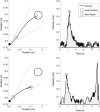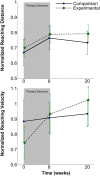Progressive Abduction Loading Therapy with Horizontal-Plane Viscous Resistance Targeting Weakness and Flexion Synergy to Treat Upper Limb Function in Chronic Hemiparetic Stroke: A Randomized Clinical Trial
- PMID: 29515514
- PMCID: PMC5825888
- DOI: 10.3389/fneur.2018.00071
Progressive Abduction Loading Therapy with Horizontal-Plane Viscous Resistance Targeting Weakness and Flexion Synergy to Treat Upper Limb Function in Chronic Hemiparetic Stroke: A Randomized Clinical Trial
Abstract
Background: Progressive abduction loading therapy has emerged as a promising exercise therapy in stroke rehabilitation to systematically target the loss of independent joint control (flexion synergy) in individuals with chronic moderate/severe upper-extremity impairment. Preclinical investigations have identified abduction loading during reaching exercise as a key therapeutic factor to improve reaching function. An augmentative approach may be to additionally target weakness by incorporating resistance training to increase constitutive joint torques of reaching with the goal of improving reaching function by "overpowering" flexion synergy. The objective was, therefore, to determine the therapeutic effects of horizontal-plane viscous resistance in combination with progressive abduction loading therapy.
Methods: 32 individuals with chronic hemiparetic stroke were randomly allocated to two groups. The two groups had equivalent baseline characteristics on all demographic and outcome metrics including age (59 ± 11 years), time poststroke (10.1 ± 7.6 years), and motor impairment (Fugl-Meyer, 26.7 ± 6.5 out of 66). Both groups received therapy three times/week for 8 weeks while the experimental group included additional horizontal-plane viscous resistance. Quantitative standardized progression of the intervention was achieved using a robotic device. The primary outcomes of reaching distance and velocity under maximum abduction loading and secondary outcomes of isometric strength and a clinical battery were measured at pre-, post-, and 3 months following therapy.
Results: There was no difference between groups on any outcome measure. However, for combined groups, there was a significant increase in reaching distance (13.2%, effect size; d = 0.56) and velocity (13.6%, effect size; d = 0.27) at posttesting that persisted for 3 months and also a significant increase in abduction, elbow extension, and external rotation strength at posttesting that did not persist 3 months. Similarly, the clinical battery demonstrated a significant improvement in participant-reported measures of "physical problems" and "overall recovery" across all participants.
Conclusion: The strengthening approach of incorporating horizontal-plane viscous resistance did not enhance the reaching function improvements observed in both groups. Data do not support the postulation that one can be trained to "overpower" the flexion synergy with resistance training targeting constitutive joint torques of reaching. Instead, flexion synergy must be targeted with progressive abduction loading to improve reaching function.
Trial registration: ClinicalTrials.gov, NCT01548781.
Keywords: exercise therapy; physical and rehabilitation medicine; physical therapy modalities; resistance training; robotics; stroke; stroke rehabilitation; upper extremity.
Figures





Similar articles
-
Progressive abduction loading therapy targeting flexion synergy to regain reaching function in chronic stroke: Preliminary results from an RCT.Annu Int Conf IEEE Eng Med Biol Soc. 2016 Aug;2016:5837-5840. doi: 10.1109/EMBC.2016.7592055. Annu Int Conf IEEE Eng Med Biol Soc. 2016. PMID: 28269582
-
Flexion synergy overshadows flexor spasticity during reaching in chronic moderate to severe hemiparetic stroke.Clin Neurophysiol. 2017 Jul;128(7):1308-1314. doi: 10.1016/j.clinph.2017.04.028. Epub 2017 May 12. Clin Neurophysiol. 2017. PMID: 28558314 Free PMC article.
-
Robotic quantification of upper extremity loss of independent joint control or flexion synergy in individuals with hemiparetic stroke: a review of paradigms addressing the effects of shoulder abduction loading.J Neuroeng Rehabil. 2016 Oct 29;13(1):95. doi: 10.1186/s12984-016-0203-0. J Neuroeng Rehabil. 2016. PMID: 27794362 Free PMC article. Review.
-
Robotic-assisted rehabilitation of the upper limb after acute stroke.Arch Phys Med Rehabil. 2007 Feb;88(2):142-9. doi: 10.1016/j.apmr.2006.10.032. Arch Phys Med Rehabil. 2007. PMID: 17270510 Clinical Trial.
-
Impairment-Based 3-D Robotic Intervention Improves Upper Extremity Work Area in Chronic Stroke: Targeting Abnormal Joint Torque Coupling With Progressive Shoulder Abduction Loading.IEEE Trans Robot. 2009 Jun 1;25(3):549-555. doi: 10.1109/TRO.2009.2017111. IEEE Trans Robot. 2009. PMID: 20657711 Free PMC article.
Cited by
-
Improving Hand Function of Severely Impaired Chronic Hemiparetic Stroke Individuals Using Task-Specific Training With the ReIn-Hand System: A Case Series.Front Neurol. 2018 Nov 7;9:923. doi: 10.3389/fneur.2018.00923. eCollection 2018. Front Neurol. 2018. PMID: 30464754 Free PMC article.
-
Cross-Frequency Coupling in Descending Motor Pathways: Theory and Simulation.Front Syst Neurosci. 2020 Jan 14;13:86. doi: 10.3389/fnsys.2019.00086. eCollection 2019. Front Syst Neurosci. 2020. PMID: 31992973 Free PMC article.
-
Assessing the Usage of Indirect Motor Pathways Following a Hemiparetic Stroke.IEEE Trans Neural Syst Rehabil Eng. 2021;29:1568-1572. doi: 10.1109/TNSRE.2021.3102493. Epub 2021 Aug 11. IEEE Trans Neural Syst Rehabil Eng. 2021. PMID: 34343095 Free PMC article.
-
Coupling of shoulder joint torques in individuals with chronic stroke mirrors controls, with additional non-load-dependent negative effects in a combined-torque task.J Neuroeng Rehabil. 2021 Sep 8;18(1):134. doi: 10.1186/s12984-021-00924-1. J Neuroeng Rehabil. 2021. PMID: 34496876 Free PMC article.
-
Beta-Band Cortico-Muscular Phase Coherence in Hemiparetic Stroke.Biomed Signal Process Control. 2024 Nov;97:106719. doi: 10.1016/j.bspc.2024.106719. Epub 2024 Aug 7. Biomed Signal Process Control. 2024. PMID: 39493553
References
Associated data
LinkOut - more resources
Full Text Sources
Other Literature Sources
Medical

